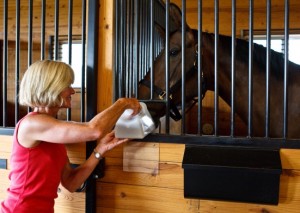Feeding Schedules for Horses

A few months ago, I received a call from a farm that was experiencing numerous cases of colic. They were concerned that their grain was the cause of the problem and asked me to visit their farm.
When I arrived at 8:30 am, the horses were just being fed. As I walked into the barn I noticed all of the stall fronts and side boards showed signs of chewing. I also noticed that many of the horses had little or no water in their buckets. Each horse received a large scoop of sweet feed and a flake of hay.
I reviewed the horses’ weight and body condition scores with the owner and trainer. Based on that assessment, I suggested they move to feeding hay at a rate of 1.5% of the horses’ body weight, and grain at the rate of 0.5 %. I also suggested going to a pelleted feed, as the horses were passing a lot of undigested grain in their manure. I encouraged the farm to select a pellet high in fiber and fat, and that contained yeast cultures to aid in the digestion process.
I then asked the farm owner to describe the daily routine at the farm. He explained once the horses are fed, they begin a daily work and turnout routine. At about noon, they are given another flake of hay or have round bales in their turnout area. By 3:30, all of the horses are brought in for their evening feeding. The evening feed consisted of a scoop of grain and two flakes of hay. The barn is closed for the day by 4:00 p.m. The horses were receiving all of their daily rations in 3 feedings, but they were within an 8 hour period.
By spanning the daily rations over a 14 hour period, ensuring full water buckets throughout the day, and following the product selection suggestions I had made, the farm has now been colic free for over 6 months!
